How to Wash a Bean Bag Pillow
To wash your bean bag pillow safely, start by checking the care label and shaking out loose debris. For machine washing, use a gentle cycle with cold water and place the pillow in a protective laundry bag with similar-colored items. If hand cleaning, spot treat stains with mild soap and water using light, circular motions. Avoid oversaturating the fabric and never use bleach or fabric softeners. After washing, lay the pillow flat to dry in a well-ventilated area, rotating occasionally to prevent clumping. For stubborn stains or delicate materials, professional cleaning might be your best option, but there's much more to contemplate when caring for your specific bean bag type.
This post may contain affiliate links. If you make a purchase through these links, I may earn a commission at no additional cost to you. Additionally, portions of this post may be generated using artificial intelligence (AI) technology. While we strive for accuracy, please be aware that AI-generated content may not always be perfect and should be fact-checked when necessary.
The Spatula Scoops
- Check the care label first and spot clean stubborn areas with mild soap and water before proceeding with full washing.
- Use a gentle cycle with cold water in the washing machine, placing the pillow inside a protective laundry bag.
- Hand wash by gently spot cleaning with a damp cloth and mild soap, avoiding oversaturation of the fabric.
- Dry the pillow flat in a well-ventilated area, rotating periodically to prevent clumping and avoid direct sunlight.
- Remove excess moisture by rolling in a towel, and ensure complete drying before use or storage to prevent mold.
Essential Pre-Washing Steps
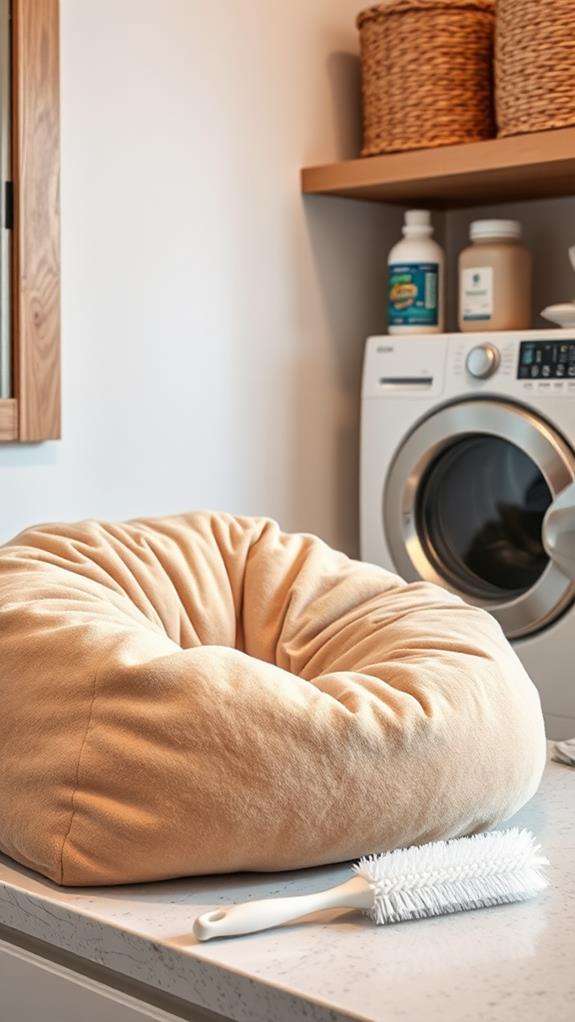
Every successful bean bag pillow cleaning starts with proper preparation. Before you plunge into washing your bean bag pillow, you'll need to follow several vital steps to guarantee the best results and protect your investment.
First, locate and carefully read the care label attached to your pillow, as these cleaning instructions will guide your entire cleaning process. Different materials require different approaches, and using the wrong method could permanently damage your pillow. Next, give your pillow a thorough shake outdoors to remove any loose dirt and debris. For stubborn spots, try spot cleaning with a damp sponge before proceeding with a full wash.
Don't skip the essential step of examining your pillow for any damage. Check every seam and surface for tears, loose stitching, or weak spots that could worsen during washing. If you find any issues, you'll need to repair them first. When you're confident about washing the pillow, test your chosen cleaning method on a small, hidden area. This test will reveal whether the fabric might fade or become damaged. If you're planning to machine wash, remember to place the pillow in a protective bag to prevent tears.
Washing Machine Guidelines
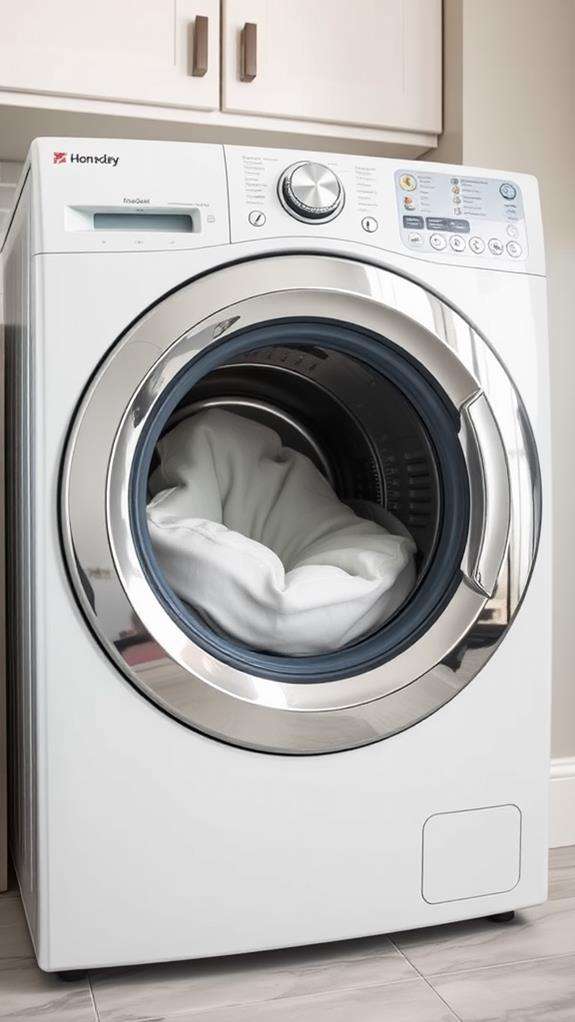
To properly wash your bean bag pillow in the machine, you'll need to select the gentle cycle setting and cold water temperature, which helps protect the fabric and filling from damage. Before starting the wash cycle, secure your pillow in a protective laundry bag or pillowcase, and add a few towels to help balance the load and reduce excessive movement. You'll want to use a mild detergent without bleach or fabric softeners, as these harsh chemicals can break down the fabric's fibers and compromise your pillow's durability.
Gentle Cycle Settings
When washing your bean bag pillow, selecting the proper machine settings plays an essential role in maintaining its quality. To wash your microbead pillow effectively, you'll need to choose the gentle cycle setting, which provides minimal agitation and helps preserve the fabric's integrity during the cleaning process.
Set your washing machine to cold or lukewarm water temperature, as this will protect the pillow's materials from potential damage like shrinkage or color fading. Before starting the cycle, you'll want to place your bean bag pillow inside a protective laundry bag or tied pillowcase, which acts as an additional barrier against wear and tear. When loading the machine, make sure to include similar colored items to prevent any unwanted color transfer and create a balanced load that reduces stress on your pillow. It's vital to avoid using harsh cleaning agents like bleach or fabric softeners, as these products can compromise the pillow's fabric quality and alter its texture. By following these gentle cycle guidelines, you'll guarantee your bean bag pillow maintains its shape, comfort, and durability throughout multiple washes.
Pre-Wash Protection Steps
Proper preparation before machine washing your bean bag pillow can make the difference between successful cleaning and potential damage. Before you begin, carefully check the care label for specific washing instructions, as different materials and fillings require different treatment approaches.
To prevent damage to your microbead pillow, enclosed protection is essential. You'll want to place your bean bag pillow inside a laundry bag or secure it within a pillowcase, making sure to tie it tightly to minimize movement during washing. This protective barrier helps prevent the fabric from stretching or tearing during the cleaning cycle.
When loading your washing machine, don't wash your bean bag pillow alone. Instead, add similar-colored items and several heavy towels to create balance and reduce excessive agitation. The towels act as buffers, protecting your pillow from unnecessary wear and tear during the wash cycle. Choose mild detergent only, as harsh chemicals can deteriorate the fabric and filling. By taking these precautionary steps, you'll maintain the integrity of your bean bag pillow while ensuring it gets thoroughly clean.
Temperature and Detergent Rules
The most critical washing machine settings for bean bag pillows revolve around temperature and detergent choices. When you're preparing to wash your bean bag pillow, you'll want to set your machine to cold or lukewarm water, as higher temperatures can cause unwanted shrinkage and potentially fade your pillow's colors. It is crucial to select a mild detergent that won't compromise the fabric's integrity or cause damage to the filling material.
You'll need to avoid harsh cleaning agents that could harm your pillow, so steer clear of bleach and fabric softeners. These products can weaken the fabric's fibers and alter the texture of your bean bag pillow over time. When selecting your washer's cycle, choose the gentle or delicate setting to minimize aggressive agitation that could damage the filling or seams. To protect your pillow's color, it's smart to wash it with items of similar shades to prevent any potential color transfer. If you're washing multiple bean bag pillows, group them by color to maintain their original appearance and prevent any unwanted dye bleeding between items.
Hand Cleaning Methods

To effectively hand-clean your bean bag pillow, start with gentle spot cleaning using a damp cloth and a mild detergent solution, making certain to test the cleaner on a hidden area first. You'll want to work methodically across soiled areas using light, circular motions with your cloth, avoiding harsh scrubbing that could damage the fabric's surface. After thoroughly addressing any stains or dirt, let your bean bag pillow air dry completely in a well-ventilated space, and you can speed up the process by occasionally rotating the pillow to guarantee even drying.
Gentle Spot Cleaning Steps
Spot cleaning your bean bag pillow requires a gentle touch and minimal moisture to maintain its quality. To begin, take a clean sponge or cloth and dampen it with mild soap and water. You'll want to work on one area at a time, focusing your attention on visible stains or marks that need addressing.
As you spot clean each section, remember not to oversaturate the fabric. Too much moisture can seep into the filling and create problems like mold or mildew. Instead, use just enough water to lift the stain effectively. Once you've treated the stained areas, take a separate damp cloth with clean water to remove any soap residue that might remain on the fabric's surface.
After cleaning, it's essential to let your bean bag pillow air dry completely. Place it in a well-ventilated area, but avoid direct sunlight which could fade or damage the fabric. While it's drying, you'll want to periodically shake and fluff the pillow to prevent any clumping of the filling material and help maintain its original shape and comfort level.
Soap Selection Guidelines
Selecting the right soap marks the difference between successful cleaning and potential damage to your bean bag pillow. When you're choosing a cleaning solution, you'll want to focus on mild detergents or dish soaps that won't compromise your pillow's fabric or color. Harsh chemicals can lead to unwanted damage, making proper soap selection essential for maintaining your bean bag's appearance and longevity.
To guarantee you're using the right cleaning products, follow these essential guidelines:
- Choose a mild detergent or dish soap specifically designed for delicate fabrics
- Avoid any cleaning solutions containing bleach or strong chemical compounds
- Test your chosen soap on a hidden area of the bean bag first
- Mix the soap with warm water to create a gentle cleaning solution
Remember that regular maintenance with the appropriate soap helps prevent dirt accumulation and extends your bean bag's life. You'll want to create a cleaning mixture that's effective yet gentle, combining warm water with just enough soap to create a mild solution. By following these soap selection guidelines, you're protecting your investment while ensuring a thorough clean that won't compromise the fabric's integrity.
Drying After Hand Wash
Proper drying techniques after hand washing are vital for maintaining your bean bag pillow's quality and preventing potential damage. After washing, you'll need to remove excess water carefully by giving your pillow gentle squeezes, but don't wring it out, as this can distort its shape and damage the fabric.
To begin the drying process, lay your pillow flat on a clean, dry towel and roll it up like a jelly roll to absorb the initial moisture. Once you've done this, unroll the towel and position your pillow in a well-ventilated area, allowing it to dry naturally. While the pillow is drying, you'll want to rotate it every few hours to guarantee even drying and prevent any moisture from getting trapped, which could lead to mildew.
Keep your pillow away from direct sunlight and heat sources during the drying process, as these can damage both the fabric and filling. It's essential to let your pillow dry completely before using it again – this might take 24-48 hours depending on humidity levels. Don't rush this final step, as a damp pillow can become a breeding ground for mold.
Proper Drying Techniques

Once you've finished washing your bean bag pillow, drying it correctly is vital to prevent mold and maintain its quality. You'll need to place it in a well-ventilated area where air can circulate freely around the entire pillow to guarantee thorough drying.
To properly dry your bean bag pillow without causing damage, follow these key steps:
- Position your pillow in a room with good air circulation, away from direct heat sources that could potentially damage the fabric or filling
- Rotate the pillow every 2-3 hours to promote even drying and maintain its original shape
- Gently pat and reshape the pillow during rotation to prevent clumping of the filling
- Check for moisture by pressing on different areas of the pillow throughout the drying process
If you're considering using a dryer, you'll want to be extra cautious. Only use the lowest heat setting and first verify that your pillow's fabric is dryer-safe. Remember that excessive heat can compromise the filling material and potentially cause the beads to break down or clump together. The drying process might take 24-48 hours, depending on humidity levels and air circulation in your space.
Stain Removal Tips
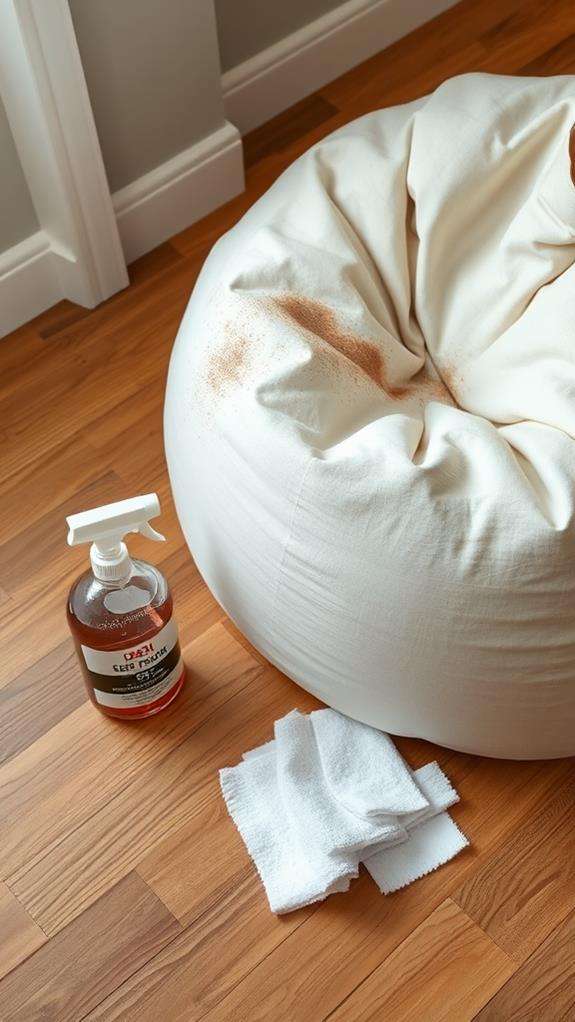
When you're dealing with stubborn stains on your bean bag pillow, start with gentle pre-treatment methods like blotting red wine stains with a dry cloth before moving to damp terry cloth applications. You'll find natural cleaning solutions, such as a mixture of water and mild dish soap, particularly effective for most everyday spots, but always test your chosen solution on a hidden area first. For the best results, tackle stains immediately using quick-action methods, working from the outer edges toward the center of the spot to prevent spreading, and avoid harsh chemicals like bleach that could damage your bean bag's fabric.
Pre-Treatment For Tough Spots
Dealing with tough stains on your bean bag pillow doesn't have to be a nightmare if you act quickly and use the right techniques. Before starting any cleaning process, you'll want to properly pre-treat those stubborn spots to guarantee the best possible outcome.
Start with these essential pre-treatment steps for different types of tough spots:
- For fresh stains, immediately blot (don't rub) the area with a clean, dry cloth to absorb as much of the spill as possible. This prevents the stain from setting deeper into the fabric.
- When tackling food-based spots, mix a solution of cold water with a few drops of mild dish soap. Apply this mixture gently to the affected area using a damp cloth, being careful not to oversaturate the fabric.
- If you're dealing with grease or oil marks, sprinkle baking soda directly on the spot and let it sit for 15 minutes. The powder will help absorb the excess oil before you begin the main cleaning process.
- Before applying any cleaning solution, always test it on an inconspicuous area first to ascertain it won't damage or discolor your bean bag's fabric.
Natural Cleaning Solutions
Natural solutions provide a safe and effective way to remove stains from your bean bag pillow without harsh chemicals. You'll find that common household items can tackle most spots and spills effectively while being gentle on your pillow's fabric.
White vinegar mixed equally with water creates an excellent cleaning solution that won't compromise your bean bag's material. When using this mixture, you'll want to apply it carefully with a clean cloth, working from the outer edges of the stain toward the center. For particularly stubborn stains, baking soda offers two powerful approaches. You can either sprinkle it directly on the affected area and let it sit for 15-20 minutes before vacuuming, or create a paste by mixing it with water for more concentrated cleaning power.
Before applying any cleaning solution, remember to first blot the stained area with a dry cloth to absorb excess liquid. This essential step prevents the stain from spreading deeper into the fabric. Always test your chosen solution on a hidden spot first to verify it won't cause any unwanted discoloration or damage to your bean bag pillow's material.
Quick-Action Stain Methods
Three vital minutes can make the difference between a temporary spill and a permanent stain on your bean bag pillow. When you're dealing with sudden spills, especially red wine, quick action is necessary to prevent lasting damage to your microbead pillow's fabric.
Follow these proven steps to tackle stains immediately:
- Grab a clean, dry cloth and blot the affected area immediately – don't rub, as this can spread the stain and push it deeper into the fabric
- Dampen a terry cloth with plain water and gently blot the stain, working from the outer edges toward the center
- If the stain persists, mix two drops of washing up liquid with water, then carefully dab the solution onto the stained area
- Always test your cleaning solution on a hidden spot first to verify it won't damage or discolor your bean bag's fabric
Remember that timing is vital when dealing with stains. The longer you wait to address a spill, the more likely it'll become a permanent feature of your bean bag pillow. Quick action and gentle treatment are your best allies in maintaining your pillow's appearance.
Maintenance and Care Instructions
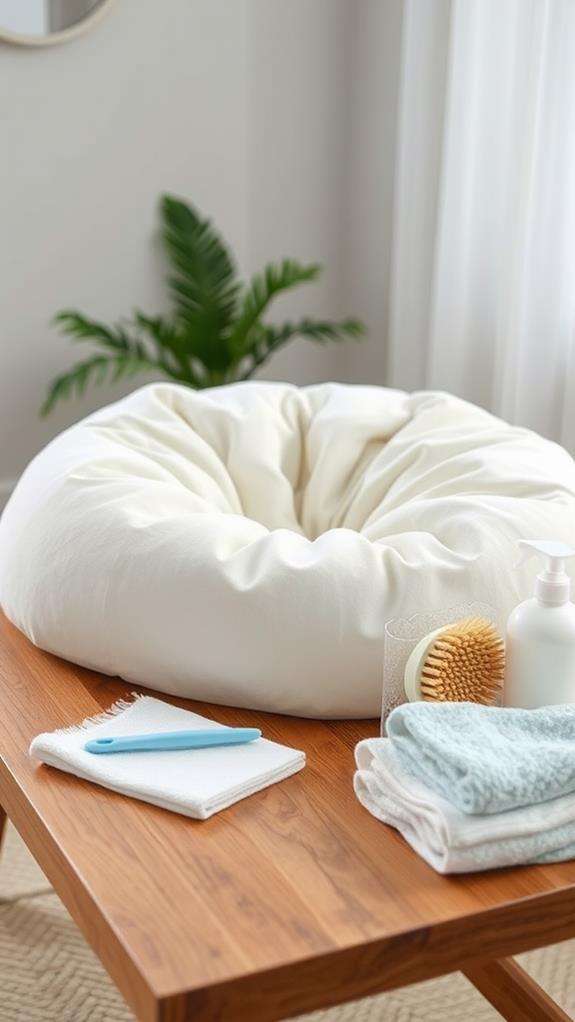
Regular maintenance of your bean bag pillow keeps it looking fresh and extends its life. You'll want to establish a cleaning routine that includes spot cleaning with a damp sponge and mild detergent, guaranteeing you tackle dirt before it becomes deeply embedded in the fabric.
Different materials require specific cleaning approaches, so it is crucial to identify your bean bag's fabric type before starting maintenance. If you've got a faux suede bean bag, use gentle brushing motions, while velvet requires careful dabbing to prevent damage to the pile. You should shake out your bean bag regularly to remove dust and promote proper airflow through the material, which helps maintain its shape and comfort level.
When cleaning, don't use bleach or harsh chemical cleaners, as they'll likely damage the fabric and cause discoloration. Instead, stick to gentle cleaning solutions specifically designed for your bean bag's material. It's also smart to keep spare covers and filling on hand for quick replacements when needed. This proactive approach to maintenance guarantees you won't have extended periods without your bean bag while waiting for replacement parts.
Safety Precautions While Washing
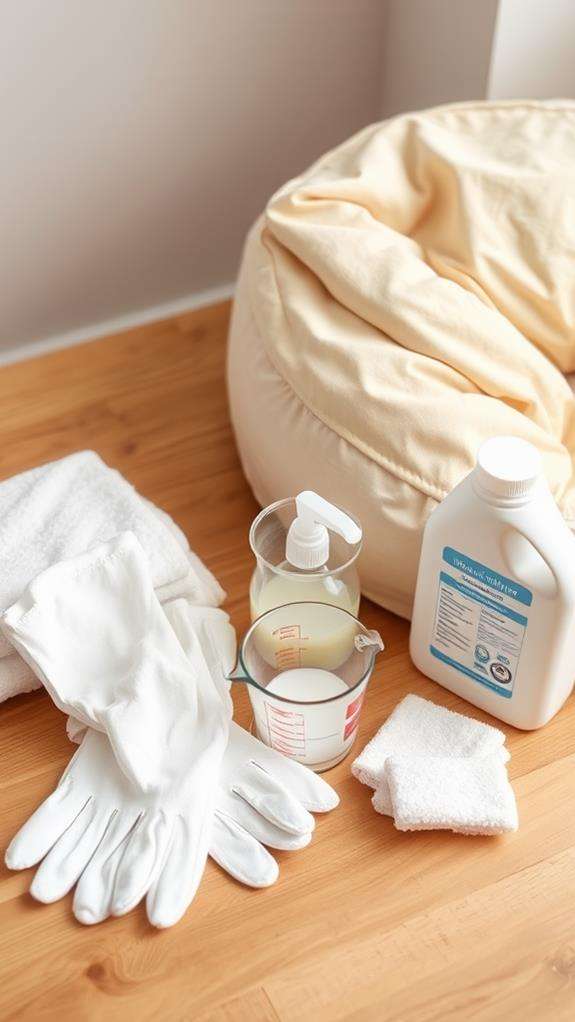
Taking proper safety measures during the washing process safeguards both your bean bag pillow and your washing machine from potential damage. Before you begin cleaning, it's essential to understand and follow important safety precautions that'll protect your investment and guarantee effective cleaning results.
- Always check the care label thoroughly before washing, as using incorrect cleaning methods can permanently damage the pillow and void any warranty protection.
- Secure all zippers and closures tightly, as loose fasteners can catch on your washing machine's drum or cause tears in the fabric during the cleaning process.
- Inspect your pillow carefully for existing wear, tears, or weak spots, marking any areas that need special attention or gentle handling.
- Avoid using harsh chemicals or bleach, which can break down the fabric fibers and compromise the pillow's structural integrity.
When spot cleaning, you'll want to use a gentle, damp cloth rather than soaking the entire pillow, as excessive moisture can lead to mold growth inside the filling. If you're machine washing, stick to mild detergents and follow the temperature settings specified on your pillow's care tag to prevent any unnecessary wear or damage.
Cleaning Different Bean Bag Materials
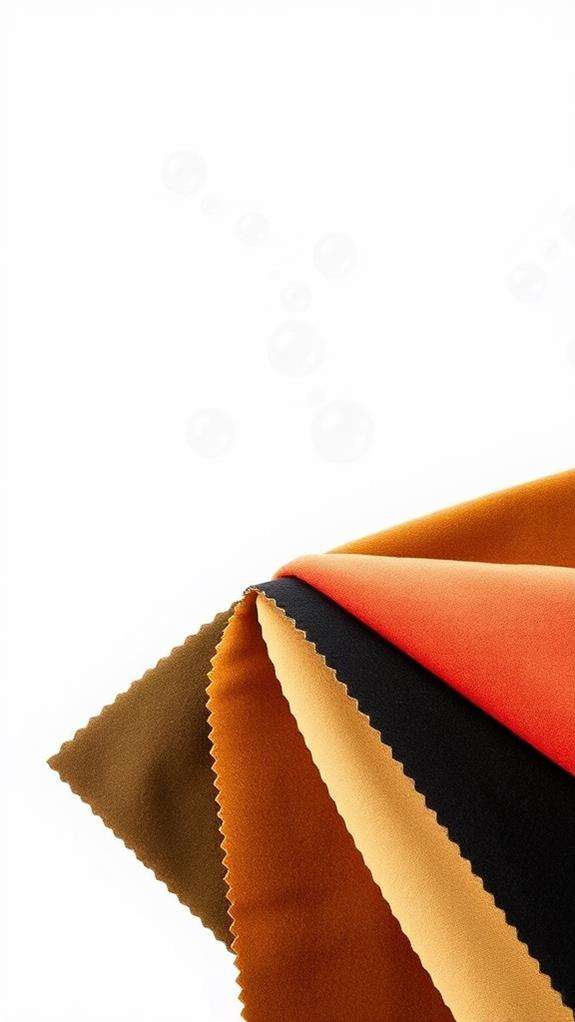
Bean bag materials vary widely in their care requirements, making it essential to understand the specific cleaning needs of your pillow's fabric. Before attempting any cleaning method, you'll want to test it on a small, hidden area to prevent potential damage or discoloration to your bean bag's surface.
For cotton bean bags, you're in luck as they're typically the easiest to maintain with simple spot cleaning techniques. If you're dealing with leather, you'll need to establish a regular cleaning routine to prevent dirt accumulation. When it comes to machine washing, always check your bean bag's care label first, as some materials are suitable for this method while others aren't. For delicate materials like velvet, you'll want to use gentle washing tips such as dabbing with a slightly damp cloth rather than rubbing, which could damage the fabric.
Whatever material your bean bag features, avoid using bleach-based products as they can cause irreversible damage. Instead, opt for gentle cleaners specifically designed for your fabric type. For faux suede, use a soft brush to maintain its texture while cleaning, and remember to follow the manufacturer's specific care instructions.
Storage Between Cleanings
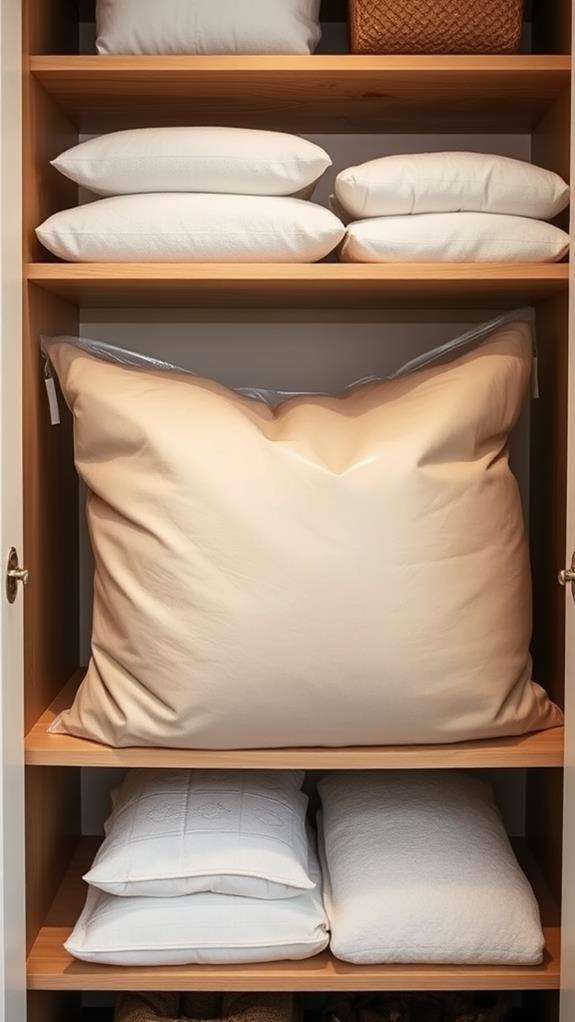
Proper storage practices between cleaning sessions help maintain your bean bag pillow's quality and extend its life. When you're not using your bean bag pillow, it's vital to store it correctly to prevent damage and deterioration. To keep your storage solutions effective, consider investing in durable containers that protect your items while offering leak-proof capabilities, like the leak-proof containers available in the Ello Duraglass Meal Prep Set. By following proper storage guidelines, you'll keep your pillow in ideal condition for years to come.
Here's what you need to do to store your bean bag pillow properly:
- Choose a cool, dry location away from direct sunlight to prevent fabric fading and material breakdown
- Place your pillow in a breathable storage bag or container that allows air circulation while protecting against dust
- Wrap the pillow in a protective cloth or dust cover to shield it from allergens and debris
- Check on your stored pillow periodically for any signs of moisture, pests, or wear
Before putting your bean bag pillow into storage, always verify it's completely dry to prevent mold and mildew growth. If you notice any dampness, let it air out thoroughly first. Remember to maintain adequate ventilation in your storage area, as proper airflow helps preserve the pillow's materials and filling over time.
Professional Cleaning Recommendations

When dealing with delicate fabrics or stubborn stains, professional dry cleaning services offer a reliable solution for maintaining your bean bag pillow. Before you take your bean bag to the cleaners, always check the care label to verify dry cleaning is suitable for your specific item. You'll want to inform the dry cleaner about the material composition of both the cover and filling to ensure they'll use appropriate cleaning methods.
| Consideration | What You Should Do |
|---|---|
| Before Visit | Check care label thoroughly |
| At Drop-off | Specify fabric type and filling |
| Stain Issues | Point out specific problem areas |
| After Service | Inspect for complete cleaning |
Professional cleaning services can effectively tackle those tough stains that haven't responded to your home cleaning attempts. They're equipped with specialized solutions and techniques that won't damage your bean bag's fabric or compromise its filling. While this option might cost more than DIY methods, it's particularly worthwhile for high-end bean bags or those made with delicate materials. Regular professional cleaning can greatly extend your bean bag pillow's lifespan, keeping it looking fresh and maintaining its original appearance over time.
Frequently Asked Questions
Can You Wash a Bean Bag in a Washing Machine?
Did you know that 73% of bean bag damage occurs from improper washing? While you can technically wash a bean bag in a washing machine, it's not recommended. You'll risk damaging both the fabric and filling. If you must machine wash, only wash the cover separately on a gentle cycle after removing the filling. Your best bet is to spot clean with a damp cloth and mild detergent to maintain your bean bag's shape and durability.
How Do You Wash a Bean Travel Pillow?
To wash your bean travel pillow, start by removing the outer cover if it's detachable. You'll want to spot clean stubborn stains with mild detergent and a damp cloth. If your pillow's machine washable, place it in a laundry bag and wash on gentle cycle with cold water. Don't use bleach or fabric softeners. Always air dry completely to prevent mold. If you need to refill it, make sure you're using compatible replacement beans.
How to Empty a Bean Bag to Wash?
Did you know that over 60% of bean bag accidents happen during filling removal? To safely empty your bean bag, first locate the zipper at the bottom or side. You'll want to slowly open it while holding the bag steady. Pour the filling into a large container or garbage bag – this prevents those tiny beads from scattering everywhere. Make sure you're shaking out any stubborn spots before washing the cover according to its care label.
Can You Wash Memory Foam Filling?
You can't wash memory foam filling in a washing machine, as it'll break apart and lose its shape. Instead, you'll need to spot clean the foam using a damp cloth with mild detergent. Don't soak the foam – just gently scrub stained areas. Let it air dry completely, keeping it away from direct sunlight and heat sources. For regular maintenance, you can vacuum the foam to remove dust and allergens.





